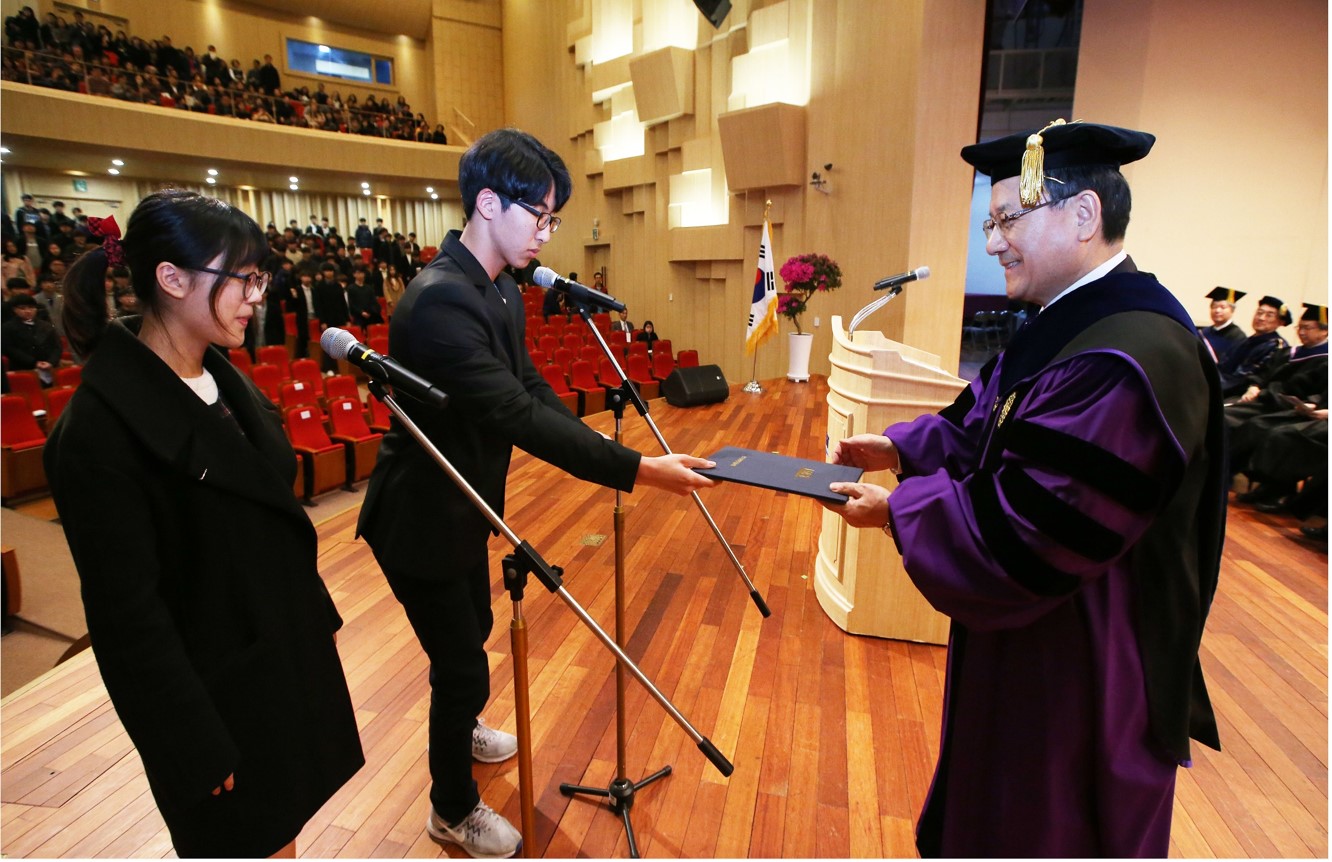policy

President Sung-Chul Shin welcomed 756 new undergraduates for 2017 during the Freshmen Convocation on February 27, urging them to be adamant in challenging themselves to become global leaders during the next four years and beyond at KAIST. Family, friends, faculty, and staff members cheered them on at the ceremony in the auditorium. The KAIST orchestra and chorus also celebrated the freshmen’s new start.
President Shin encouraged students to become global leaders by deepening their knowledge of basic studies as well as broadening their interdisciplinary spectrum while studying at KAIST.
“In the era of Industry 4.0, new discoveries will be made in interdisciplinary studies. Thus, I ask you to study humanities and social studies very diligently, the basis of creative research and development to broaden your knowledge spectrum. Conventionally, the science and technology fields are dominated by left-sided brains working while the humanities and social sciences are influenced by the right brain. KAIST will soon provide a new curriculum of full-brain teaching which will actively stimulate both sides of the brain. Such a new track will help students fully exercise their ingenuity, especially in comprehending the newest trends of science and technology,” he said.
He added, “Korea stands as one of seven most innovative nations with significant growth potential and the world is paying attention to us. You are the top 0.3 percent of science and technology talents in the nation who will be the leaders of our future. Thus, we plan to establish the Global Leadership Center in order to train our students to be outstanding leaders through their qualifications, manner, and mindset.”
He also cited communication skills as a critical aspect that every student, especially those majoring in science and technology, should focus on. “Communication is a critical tool for any scientist and leader. Students should study and learn how to better present themselves and deliver what they think more effectively and persuasively to others in the hyper-connected, horizontal society of the future. In particular, English communication skills are very crucial for engaging in leadership roles on the global stage.”
Finally, President Shin asked students to manage their time well in order to accomplish their goals. “Your future will be determined by what dreams you dream in college and how you prepare for it. I hope that your days at KAIST will be a time of diligent preparation for your ambitious dreams,” he added.
For full context of his speech, please click.

(Photo caption: President Shin makes a welcoming address at the 2017 Freshmen Convocation (above) and freshmen representatives present the oath of freshmen to President Shin.)
-
research KAIST Develops Retinal Therapy to Restore Lost Vision
Vision is one of the most crucial human senses, yet over 300 million people worldwide are at risk of vision loss due to various retinal diseases. While recent advancements in retinal disease treatments have successfully slowed disease progression, no effective therapy has been developed to restore already lost vision—until now. KAIST researchers have successfully developed a novel drug to restore vision. < Photo 1. (From left) Ph.D. candidate Museong Kim, Professor Jin Woo Kim, a
2025-03-31 -
research KAIST provides a comprehensive resource on microbial cell factories for sustainable chemical production
In silico analysis of five industrial microorganisms identifies optimal strains and metabolic engineering strategies for producing 235 valuable chemicals Climate change and the depletion of fossil fuels have raised the global need for sustainable chemical production. In response to these environmental challenges, microbial cell factories are gaining attention as eco-friendly platforms for producing chemicals using renewable resources, while metabolic engineering technologies to enhance these
2025-03-27 -
research KAIST Captures Protein Reaction in Just Six Milliseconds
Understanding biomolecular processes - such as protein-protein interactions and enzyme-substrate reactions that occur on the microseconds to millisecond time scale is essential for comprehending life processes and advancing drug development. KAIST researchers have developed a method for freezing and analyzing biochemical reaction dynamics within a span of just a few milliseconds, marking a significant step forward in better understanding complex biological reactions. < Photo. (From left)
2025-03-24 -
research KAIST Develops Eco-Friendly, Nylon-Like Plastic Using Microorganisms
Poly(ester amide) amide is a next-generation material that combines the advantages of PET (polyester) and nylon (polyamide), two widely used plastics. However, it could only be produced from fossil fuels, which posed environmental concerns. Using microorganisms, KAIST researchers have successfully developed a new bio-based plastic to replace conventional plastic. KAIST (represented by President Kwang Hyung Lee) announced on the 20th of March that a research team led by Distinguished Professor
2025-03-24 -
research KAIST Captures Hot Holes: A Breakthrough in Light-to-Electricity Energy Conversion
When light interacts with metallic nanostructures, it instantaneously generates plasmonic hot carriers, which serve as key intermediates for converting optical energy into high-value energy sources such as electricity and chemical energy. Among these, hot holes play a crucial role in enhancing photoelectrochemical reactions. However, they thermally dissipate within picoseconds (trillionths of a second), making practical applications challenging. Now, a Korean research team has successfully devel
2025-03-17